Abstract
The RMZ cell line was established from a bone marrow metastasis of a human alveolar rhabdomyosarcoma. Since the beginning of the in vitro culture, RMZ cells showed differentiation-related morphological heterogeneity: actively proliferating polygonal or spindle-shaped cells were observed along with a few multinucleated myotube-like structures and giant cells, frequently multinucleated. All these cell types were still present after over 40 passages. A set of clonal derivatives has been obtained from the second in vitro subculture. All the clones showed the same morphological heterogeneity of the parental cells, but differed from one another in the degree of differentiation. Multinucleated myotube-like structures were strongly stained by anti-desmin antibody; most mononuclear cells were weakly stained. About 80% of RMZ and cloned cells were scored as desmin-positive in cytocentrifuged preparations. The expression of embryonic myosin heavy chain, specifically recognized by the monoclonal antibody BF-G6, was found in RMZ cell line and was localised in the myotube-like structures. Only a few giant cells and rare mononucleated polygonal cells were stained. The average proportion of BF-G6 positive cells in cytocentrifuged preparations was of about 6% of the total RMZ cells. In the two RMZ clones studied, the expression of embryonic myosin was correlated to the proportion of myotube-like structures: a BF-G6 positivity of 35% was found in the most differentiated one.
Full text
PDF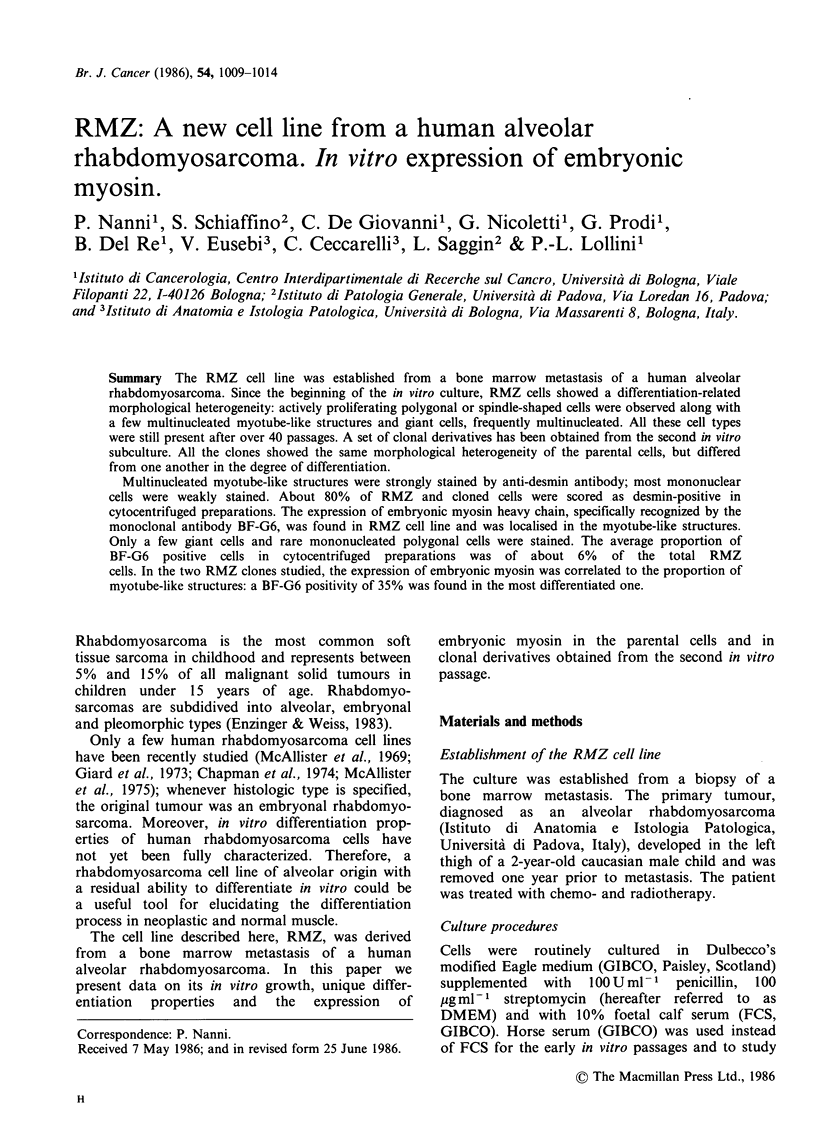
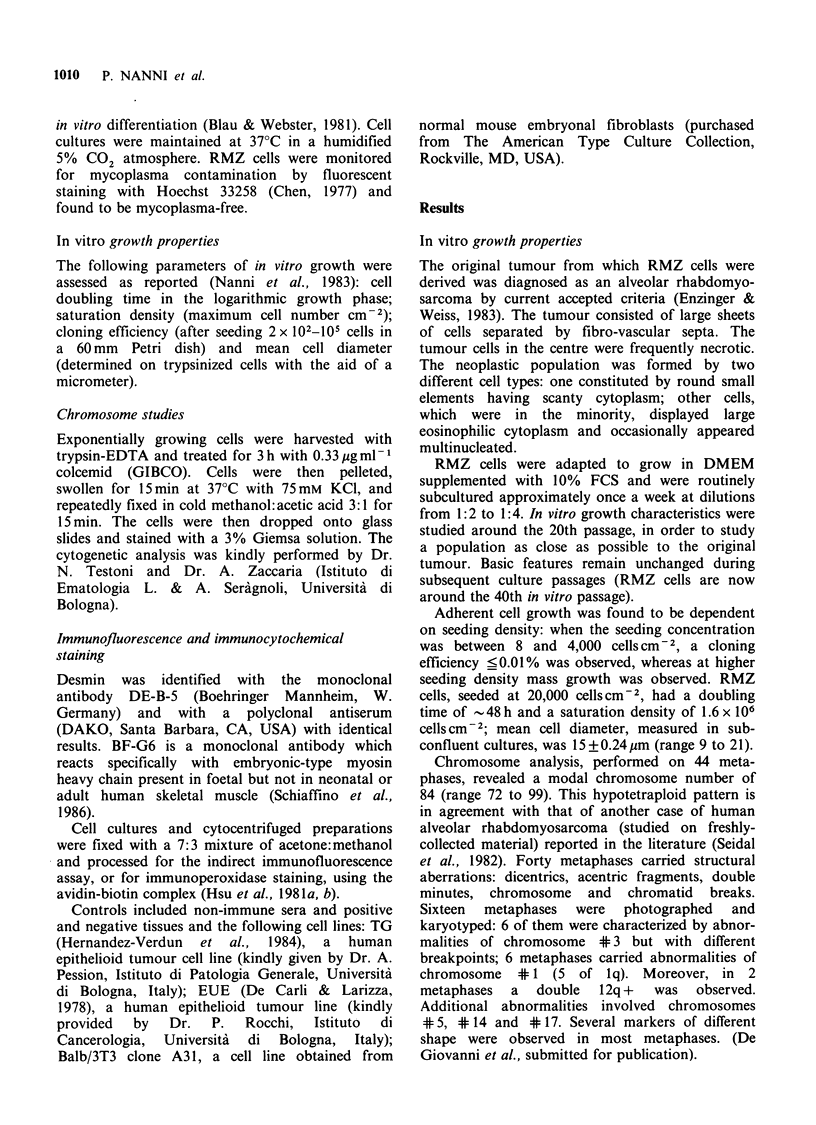
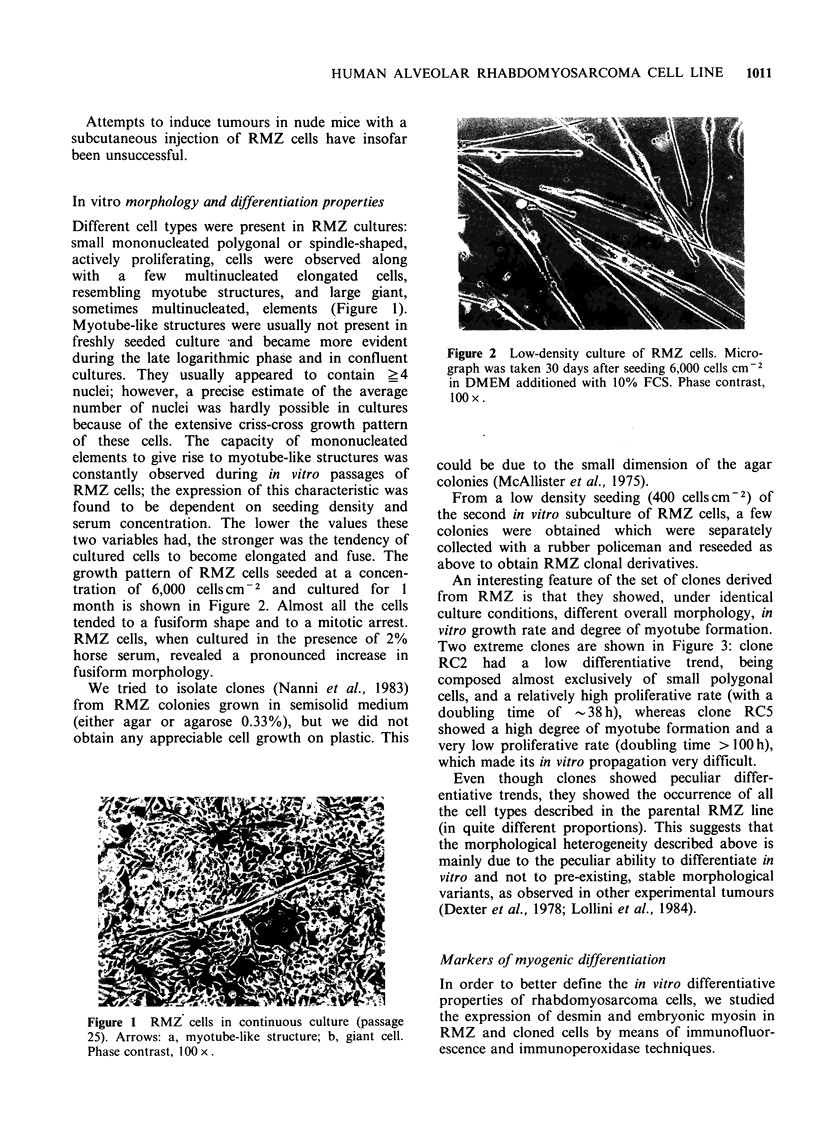
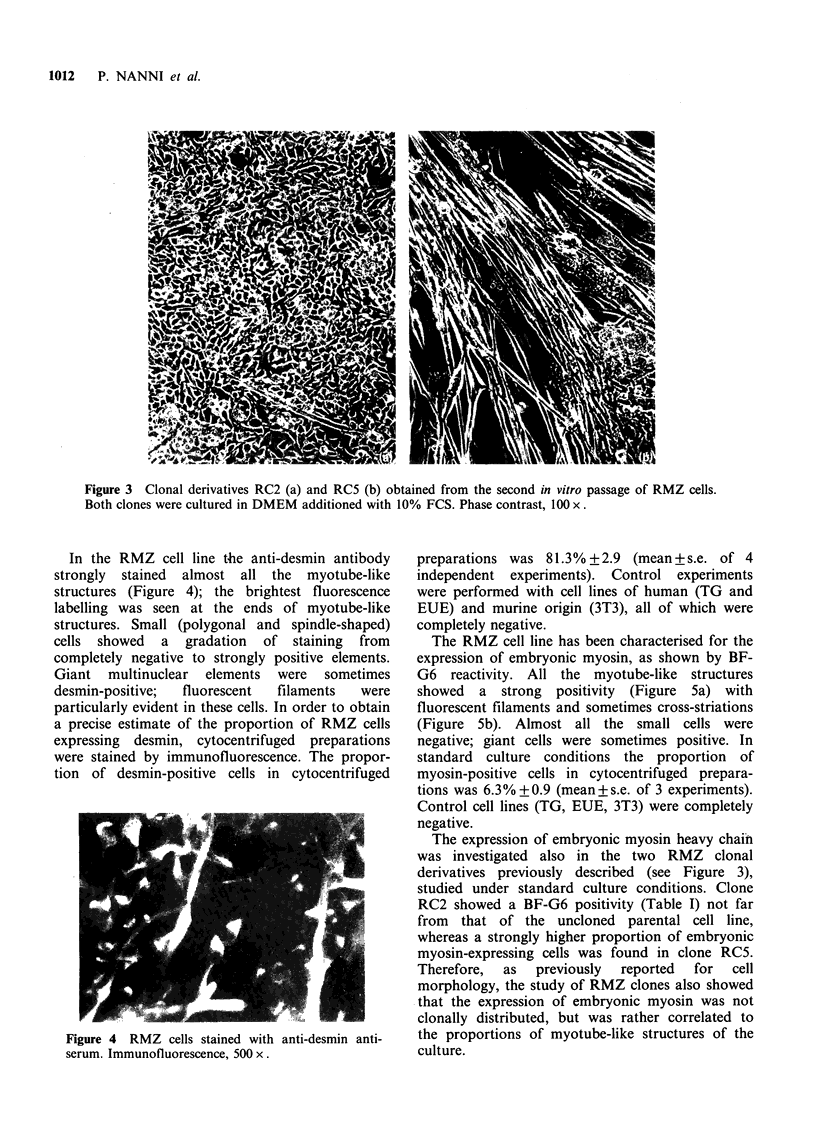
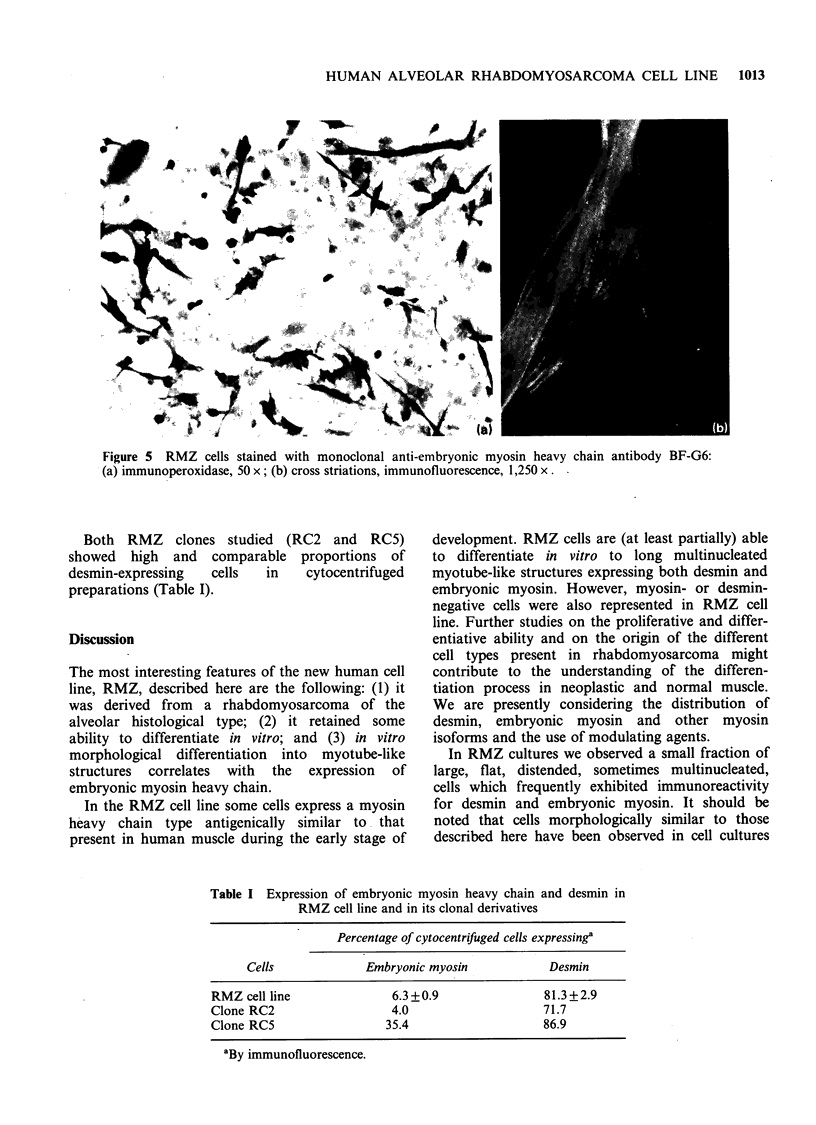
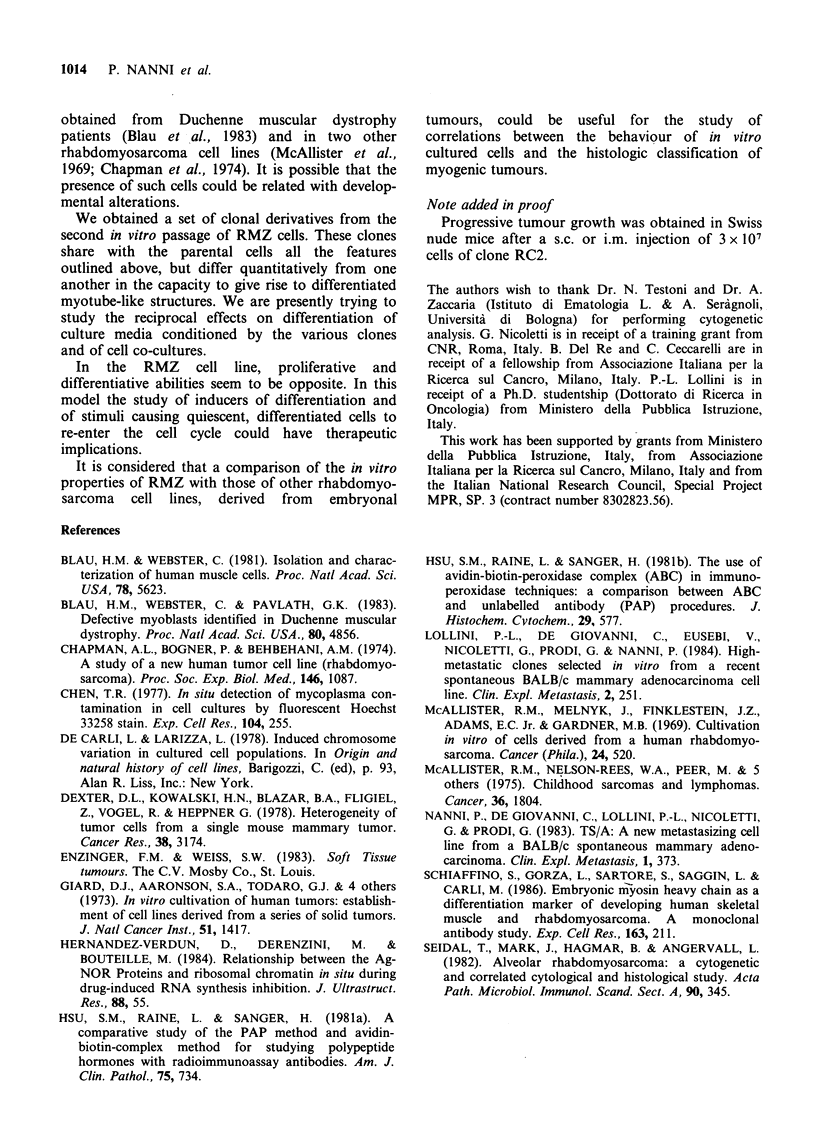
Images in this article
Selected References
These references are in PubMed. This may not be the complete list of references from this article.
- Blau H. M., Webster C. Isolation and characterization of human muscle cells. Proc Natl Acad Sci U S A. 1981 Sep;78(9):5623–5627. doi: 10.1073/pnas.78.9.5623. [DOI] [PMC free article] [PubMed] [Google Scholar]
- Blau H. M., Webster C., Pavlath G. K. Defective myoblasts identified in Duchenne muscular dystrophy. Proc Natl Acad Sci U S A. 1983 Aug;80(15):4856–4860. doi: 10.1073/pnas.80.15.4856. [DOI] [PMC free article] [PubMed] [Google Scholar]
- Chapman A. L., Bogner P., Behbehani A. M. A study of a new human tumor cell line (rhabdomyosarcoma). Proc Soc Exp Biol Med. 1974 Sep;146(4):1087–1092. doi: 10.3181/00379727-146-38250. [DOI] [PubMed] [Google Scholar]
- Chen T. R. In situ detection of mycoplasma contamination in cell cultures by fluorescent Hoechst 33258 stain. Exp Cell Res. 1977 Feb;104(2):255–262. doi: 10.1016/0014-4827(77)90089-1. [DOI] [PubMed] [Google Scholar]
- Dexter D. L., Kowalski H. M., Blazar B. A., Fligiel Z., Vogel R., Heppner G. H. Heterogeneity of tumor cells from a single mouse mammary tumor. Cancer Res. 1978 Oct;38(10):3174–3181. [PubMed] [Google Scholar]
- Giard D. J., Aaronson S. A., Todaro G. J., Arnstein P., Kersey J. H., Dosik H., Parks W. P. In vitro cultivation of human tumors: establishment of cell lines derived from a series of solid tumors. J Natl Cancer Inst. 1973 Nov;51(5):1417–1423. doi: 10.1093/jnci/51.5.1417. [DOI] [PubMed] [Google Scholar]
- Hernandez-Verdun D., Derenzini M., Bouteille M. Relationship between the Ag-NOR proteins and ribosomal chromatin in situ during drug-induced RNA synthesis inhibition. J Ultrastruct Res. 1984 Jul;88(1):55–65. doi: 10.1016/s0022-5320(84)90181-3. [DOI] [PubMed] [Google Scholar]
- Hsu S. M., Raine L., Fanger H. A comparative study of the peroxidase-antiperoxidase method and an avidin-biotin complex method for studying polypeptide hormones with radioimmunoassay antibodies. Am J Clin Pathol. 1981 May;75(5):734–738. doi: 10.1093/ajcp/75.5.734. [DOI] [PubMed] [Google Scholar]
- Hsu S. M., Raine L., Fanger H. Use of avidin-biotin-peroxidase complex (ABC) in immunoperoxidase techniques: a comparison between ABC and unlabeled antibody (PAP) procedures. J Histochem Cytochem. 1981 Apr;29(4):577–580. doi: 10.1177/29.4.6166661. [DOI] [PubMed] [Google Scholar]
- Lollini P. L., de Giovanni C., Eusebi V., Nicoletti G., Prodi G., Nanni P. High-metastatic clones selected in vitro from a recent spontaneous BALB/c mammary adenocarcinoma cell line. Clin Exp Metastasis. 1984 Jul-Sep;2(3):251–259. doi: 10.1007/BF00132932. [DOI] [PubMed] [Google Scholar]
- McAllister R. M., Melnyk J., Finkelstein J. Z., Adams E. C., Jr, Gardner M. B. Cultivation in vitro of cells derived from a human rhabdomyosarcoma. Cancer. 1969 Sep;24(3):520–526. doi: 10.1002/1097-0142(196909)24:3<520::aid-cncr2820240313>3.0.co;2-m. [DOI] [PubMed] [Google Scholar]
- McAllister R. M., Nelson-Rees W. A., Peer M., Laug W. E., Isaacs H., Jr, Gilden R. V., Rongey R. W., Gardner M. B. Childhood sarcomas and lymphomas. Characterization of new cell lines and search for type-C virus. Cancer. 1975 Nov;36(5):1804–1814. doi: 10.1002/1097-0142(197511)36:5<1804::aid-cncr2820360535>3.0.co;2-l. [DOI] [PubMed] [Google Scholar]
- Nanni P., de Giovanni C., Lollini P. L., Nicoletti G., Prodi G. TS/A: a new metastasizing cell line from a BALB/c spontaneous mammary adenocarcinoma. Clin Exp Metastasis. 1983 Oct-Dec;1(4):373–380. doi: 10.1007/BF00121199. [DOI] [PubMed] [Google Scholar]
- Schiaffino S., Gorza L., Sartore S., Saggin L., Carli M. Embryonic myosin heavy chain as a differentiation marker of developing human skeletal muscle and rhabdomyosarcoma. A monoclonal antibody study. Exp Cell Res. 1986 Mar;163(1):211–220. doi: 10.1016/0014-4827(86)90574-4. [DOI] [PubMed] [Google Scholar]
- Seidal T., Mark J., Hagmar B., Angervall L. Alveolar rhabdomyosarcoma: a cytogenetic and correlated cytological and histological study. Acta Pathol Microbiol Immunol Scand A. 1982 Sep;90(5):345–354. doi: 10.1111/j.1699-0463.1982.tb00105_90a.x. [DOI] [PubMed] [Google Scholar]







